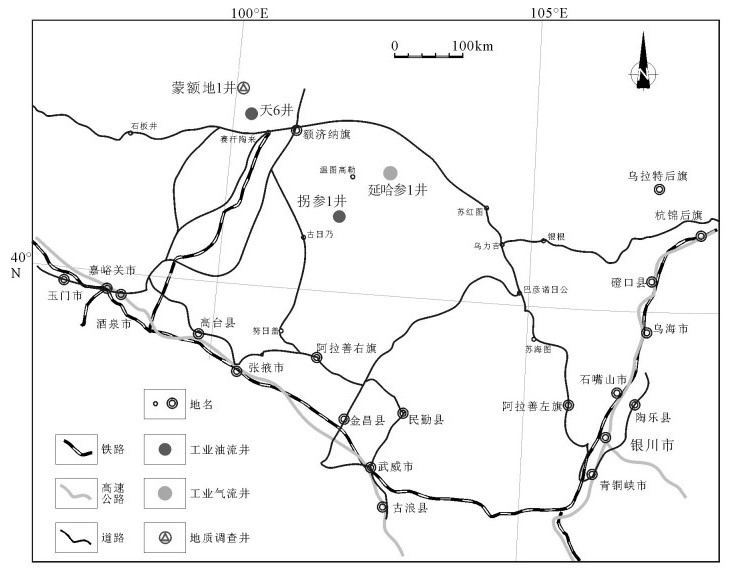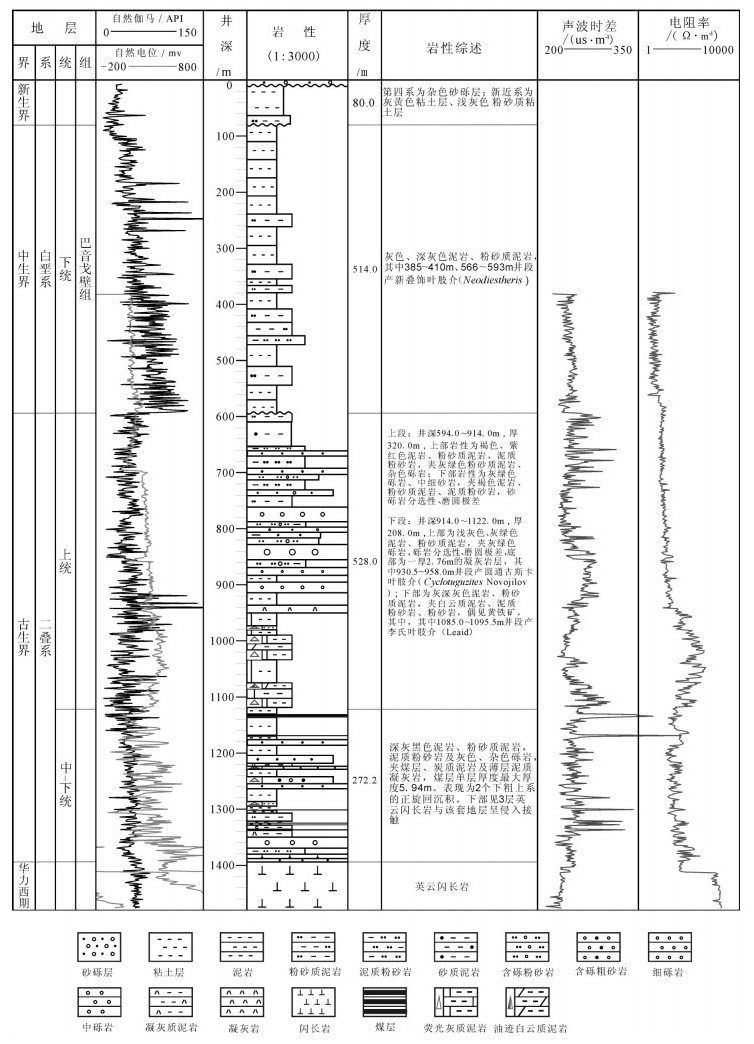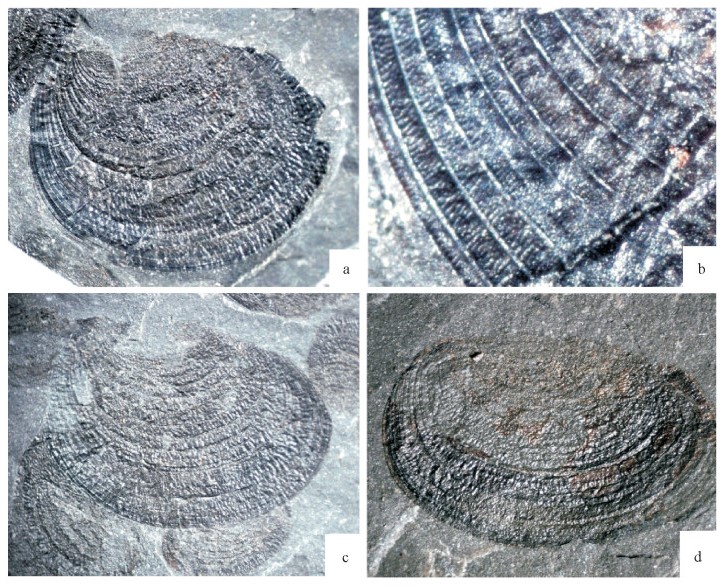The discovery of Permian Estheria in the core of No. 1 Meng' edi well, western Yingen-Ejin basin, and its significance
-
摘要:
近年来,银额盆地油气勘探不断取得新发现与突破,但对钻井地层划分及主要油气产层时代存在巨大争议,或认为产层为白垩系,或认为产层属二叠系。2017年实施的蒙额地1井钻井及取心工作,在930.5~958.0m井段的灰色、灰绿色粉砂质泥岩、泥岩层和1085.0~1095.5m井段的深灰色泥岩层中发现叶肢介化石。第一层段叶肢介为加氏圆通古斯卡叶肢介(比较种)Cyclotunguzites cf. gazimuri Novojilov,第二层段叶肢介为额济纳旗半圆李氏叶肢介(新种) Hemicycloleaia ejinaqiensis Niu(sp.nov.)和内蒙古点列叶肢介(新种)Polygrapta neimengguensis Niu(sp.nov.),均为晚二叠世代表性叶肢介。在此基础上,通过钻井地层对比,明确了银额盆地主要油气发现井的产层为二叠系。叶肢介具有重要的生物古地理指示意义,通过二叠纪叶肢介的区域分布与对比,结合银额盆地石炭纪—二叠纪地层层序分析,进一步限定了古亚洲洋的闭合时限为前石炭纪。
Abstract:In recent years, the oil and gas exploration in Yingen-Ejin basin keeps achieving significant findings and breakthroughs. However, stratigraphic division of drill holes and corresponding age of oil and gas reservoir remain much controversial. Some researchers hold that the reservoir would be Cretaceous layers, some opponents raise the idea of Permian. For the purpose of constructing stratigraphic succession in such a basin, No.1 Meng'edi well was drilled and cored in western Yingen-Ejin basin. Within this well, Estheria fossils were found in 930.5~958.0m section composed of gray to greyish green silty mudstone and mudstone layers, and in 1085.0~1095.5m section composed of dark gray mudstone layers, respectively. Therefore, Estheria fossils in the former well section were identified as Cyclotunguzites cf. gazimuri Novojilov, whereas those in latter section were identified as Hemicycloleaia ejinaqiensis Niu(sp.nov.) and Polygrapta neimengguensis Niu(sp.nov.). All of these Estheria fossils were assigned to the period of Permian. In addition to the evidence of stratigraphic correlation between drilling wells, the age of oil and gas reservoir was judged as Permian layers. Besides, Estheria fossils contain great indicating meaning in paleobiogeography. Based on comparing the distribution of Permian Estheria as well as analyzing the Carboniferous-Permian succession of Yingen-Ejin basin, the closing time of Paleo-Asian Ocean has been further constrained to Pre-Carboniferous.
-
Keywords:
- Yingen-Ejin basin /
- Permian /
- Estheria /
- oil and gas reservoir age
-
扩张脊俯冲作为板块运动重要过程的概念始于板块边界三联点和板片窗的鉴别[1-2]。这种板片窗不同于俯冲板片运移至地幔深处后的撕裂和拆沉,仅指扩张脊进入俯冲带的构造过程[3]。扩张脊俯冲不仅预示大洋板块停止生长,导致蛇绿岩的形成和侵位,还会由于俯冲板片脱水交代地幔楔、热的软流圈地幔通过板片窗上涌引发一系列的岩浆热事件,产生特殊的构造、沉积岩、变质岩和岩浆岩,以及异常流体活动和成矿[3-4]。一般在板片窗部位形成洋岛玄武岩(OIB)型和洋中脊玄武岩(MORB)型及两者过渡型岩石,在板片窗两侧区域形成钙碱性岩浆岩,包括MORB型岩浆岩、富Nb玄武岩、高镁安山岩、玻安岩、埃达克岩、S/I/A型花岗岩等[5-12],并富集形成大型、超大型铜金矿床[4, 13-14]。
班公湖-怒江洋(简称班怒洋)自早二叠世陆缘裂解至早白垩世闭合,经历了复杂的构造演化过程,其中,班怒洋的俯冲极性(单向北或双向南北)和初始俯冲时间还存在争议[15-18],而厘定扩张脊俯冲能够较好地限定洋盆从伸展扩张向俯冲汇聚构造转变,为班怒洋的构造演化历史提供约束。笔者在开展班公湖-怒江缝合带(BNSZ)东段丁青蛇绿岩1:5万区域地质填图的基础上,对宗白增生杂岩的岩石组成和内部构造进行了研究,报道了侵入泥页岩中的辉长岩脉全岩地球化学和Sr-Nd同位素,讨论了辉长岩的岩浆源区、成因和构造环境,以期对BNSZ中特提斯洋的演化提供约束。
1. 区域地质背景
青藏高原是一个长约2500 km、宽约1000 km的巨型复合造山带,是由阿尔金-祁连-昆仑山原特提斯复合造山系、松潘-羌塘-三江-拉萨古特提斯复合造山系和拉萨冈底斯-喜马拉雅新特提斯造山系组成的巨型复合碰撞造山拼贴体[19-20]。BNSZ和印度河-雅鲁藏布江缝合带(IYSZ)分别被认为是中特提斯洋(或新特提斯洋北支洋盆)和新特提斯洋(或新特提斯洋南支洋盆)的上地幔残余,前者由蛇绿岩、洋岛或海山、浊积岩和混杂岩组成,在中国境内宽10~130 km,长约2000 km[17, 21-22]。BNSZ按蛇绿岩/蛇绿混杂岩的空间分布被分为西段(班公湖—阿索)、中段(尼玛—索县)和东段(巴达—碧土)[17](图 1)。丁青蛇绿岩位于BNSZ东段,被宗白增生杂岩分为丁青东和丁青西2个蛇绿岩体(图 2-a),面积分别约为400 km2和150 km2。丁青东岩体西起协雄村东至类乌齐县的卡玛多乡,长约88.5 km,南北宽2~8 km,产状为北陡南缓同北向倾斜,南界倾向NE,倾角40°~50°,北界亦倾向NE,倾角70°~80°;丁青西岩体西起色扎乡贡桑,东至仲佰村,全长约30 km,宽2.5~8 km不等,产状与东岩体不同,呈相向倾斜,北界倾向SE或SW,倾角30°~50°,南界倾向NE或NW,倾角20°~50°[25],与实测产状吻合(图 2-b)。丁青西岩体缺失镁铁质堆晶杂岩和席状岩墙群,主要包括方辉橄榄岩、基性熔岩和海相沉积物[26-27]。
![]() 图 1 班公湖-怒江缝合带(BNSZ)、狮泉河-纳木错混杂岩带(SNMZ)、印度河-雅鲁藏布江缝合带(IYSZ)蛇绿岩分布简图(据参考文献[17]修改)ATF—阿尔金断裂;JSSZ—金沙江缝合带;KF—喀喇昆仑断裂;LMF—洛巴堆-米拉山断裂;LSSZ—龙木错-双湖-澜沧江缝合带;SS—松多缝合带Figure 1. Tectonic outline of the Tibetan Plateau showing the distribution of ophiolites in Bangong -Nujiang Suture Zone(BNSZ), Shiquan River-Namtso Mélange Zone(SNMZ)and Indus-Yarlung Zangbo Suture Zone(IYSZ)
图 1 班公湖-怒江缝合带(BNSZ)、狮泉河-纳木错混杂岩带(SNMZ)、印度河-雅鲁藏布江缝合带(IYSZ)蛇绿岩分布简图(据参考文献[17]修改)ATF—阿尔金断裂;JSSZ—金沙江缝合带;KF—喀喇昆仑断裂;LMF—洛巴堆-米拉山断裂;LSSZ—龙木错-双湖-澜沧江缝合带;SS—松多缝合带Figure 1. Tectonic outline of the Tibetan Plateau showing the distribution of ophiolites in Bangong -Nujiang Suture Zone(BNSZ), Shiquan River-Namtso Mélange Zone(SNMZ)and Indus-Yarlung Zangbo Suture Zone(IYSZ)丁青蛇绿岩层序在东岩体的沙贡乡扎西觉-协堆村剖面出露最全,主要包括地幔橄榄岩、堆晶杂岩(斜方辉石岩、二辉石岩、辉长岩)、均质中细粒辉长岩、席状墙群(辉绿岩、辉长岩、苏长岩,宽约200 m,被英云闪长岩、斜长花岗岩等岩脉侵入)、玄武岩和海相沉积物,地幔橄榄岩由方辉橄榄岩和纯橄岩组成,洋壳端元呈南北对称分布[26-30]。按照结构、构造和矿物成分的不同,方辉橄榄岩被划分为块状、斑杂状、辉石定向、球粒状和斑块状方辉橄榄岩;纯橄岩包括出露于铬铁矿外围的薄壳状、方辉橄榄岩中的透镜状和脉状及不规则团块状3种类型[27]。
丁青蛇绿岩记录了班怒洋复杂的洋盆演化历史。扎西觉-协堆村剖面中的堆晶杂岩和席状岩群中的辉长岩、辉绿岩和斜长花岗岩均具有富Si、Mg、Ni、Cr,贫Ti玻安岩系的特点[31-32];其中均质中细粒辉长岩、具有玻安质特征的英云闪长岩和斜长花岗岩的锆石U-Pb年龄分别为184.2 Ma、183.9 Ma和182.6 Ma(待发表),该年龄与丁青东岩体玻安质辉长岩和斜长花岗岩的年龄(分别为187 Ma和185 Ma)[33],以及与拉拉卡剖面中侵入方辉橄榄岩的辉石岩年龄(186 Ma)[34]吻合。除玻安质特征外,丁青东岩体的席状辉绿岩墙和杏仁状玄武岩还具有低K、Si和中Ti拉斑玄武岩的特征[29]。218 Ma纳永拉堆晶辉长岩稀土元素总量ΣREE较低(平均45.05× 10-6),球粒陨石标准化的(Ce/Yb)N值平均为1.3[35],具有亏损堆晶辉长岩的特点。东岩体协雄村附近(北纬31°21′52.0″、东经95°45′58.5″)175 Ma均质辉长岩TiO2 < 0.1%,ΣREE平均4.23×10-6,具有Nb、Ta、Zr、Hf和Th元素负异常,锆石εHf(t)=11.7~14.6,TDMC=287~474 Ma,指示了俯冲带亏损型堆晶辉长岩的成分特征;而侵入该均质辉长岩中的淡色辉长岩脉虽然对全岩地球化学数据未报道,但其锆石年龄为164 Ma,εHf(t)= 4.0~6.6,TDMC=792~995 Ma,指示了明显不同于围岩辉长岩的地幔源区特征[36-37]。此外,沙贡乡拉根拉硅质岩的放射虫时代为晚三叠世[38],与基性熔岩互层的瓦弄硅质岩的放射虫时代为侏罗纪[30]。总之,不同时代不同性质洋壳岩石的出露暗示丁青蛇绿岩记录了古洋盆多阶段构造演化过程。
丁青蛇绿岩北侧为晚三叠世—早中侏罗世火山-沉积岩建造,岩性主要为变凝灰岩、火山碎屑岩、板岩、杂砂岩、页岩和灰岩,与蛇绿岩体呈断层接触,断层面倾向NE,倾角70°~80°,在接触带可见构造角砾岩,宽数米至十几米不等,砾石成分以硅质岩、蛇纹石化地幔橄榄岩、火山岩等为主[30]。火山-沉积岩建造北侧整体为陆缘碎屑沉积,包括中侏罗统德极国组(黑色页岩夹泥质结核、岩屑长石石英砂岩与泥页岩互层、粉砂质泥页岩等,为一套向上变细的滨岸陆源碎屑沉积)、中侏罗统德吉弄组(粉砂质微晶灰岩、粉砂质泥岩、钙质泥岩夹微晶灰岩、细粒长石石英砂岩、复成分砾岩等,为一套浅海陆棚至陆棚边缘碳酸盐岩及陆源碎屑沉积),以及上侏罗统机末组(泥晶灰岩,为进积型碳酸盐岩-台地潮坪沉积)[39]。德极国组与丁青方辉橄榄岩和放射虫硅质岩断层接触[27, 32]。蛇绿岩南侧主要与竟柱山组磨拉石建造断层接触,后者被陆相沉积的宗白组不整合覆盖。丁青东蛇绿岩东段南侧与三叠系罗冬群构造接触。
2. 宗白增生杂岩
增生杂岩又称增生楔或增生棱,是洋内或洋陆俯冲过程中形成的楔形地质体,主要由原地物质海沟浊积岩连续单元和异地体混杂岩两部分组成,其中混杂岩包括:①海沟垮塌堆积岩;②远洋-半远洋沉积岩、洋岛或海山、蛇绿岩;③高压变质岩三部分。增生杂岩最典型的构造样式有双冲构造(duplex)、不对称褶皱、叠瓦状无序逆冲构造和布丁构造等,其中逆冲断层中常发育S-C组构、旋转碎斑、透入性面理等[40-42]。
宗白增生杂岩位于丁青东、西蛇绿岩体之间,距丁青县城北约4 km的亚宗村附近,前人称之为宗白蛇绿混杂岩[25, 43-44]。通过对宗白增生杂岩开展1:5万地质填图,初步厘定其由亚宗混杂岩和陆缘碎屑岩两部分组成。亚宗混杂岩主要出露在郭吉寺—仲佰村—亚宗村一带,岩性沿NE走向从西到东出露蛇纹石化方辉橄榄岩、蛇纹岩、枕状玄武岩、低变质岩带(最宽约150 m,细粒变质杂砂岩、绿泥石英片岩、千枚岩、变凝灰岩)、砾岩带、玄武质凝灰岩夹薄层泥硅质岩,以及作为主要基质的泥页岩夹薄层杂砂岩,这些“岩带”走向为135°~155°(图版Ⅰ-a)。笔者在混杂岩北部圈出了地幔橄榄岩转石范围,岩性主要为含纯橄岩条带、斜方辉石和铬尖晶石定向的方辉橄榄岩(图 2-b)。基质中出露蛇纹岩、拉斑质枕状玄武岩、红褐色放射虫硅质岩、OIB型和过渡型玄武岩和玄武质碎屑岩等岩块,以及侵入泥页岩基质中的辉长岩脉,这些特征与前人报道的基本一致[25, 43-44]。OIB型玄武岩由玄武质角砾岩和玄武质熔岩互层产出,约有6层,每层厚3.5~4 m,最大长度在30 m以上,玄武质角砾岩中的砾石多呈椭圆状或浑圆状,直径5~50 cm不等,玄武质角砾岩的下部围岩为泥页岩夹泥硅质岩,产状2°∠27°~15°∠37°。辉长岩脉沿90°~110°走向断续侵入于泥页岩夹杂砂岩中(图版Ⅰ-b、c),与围岩走向(产状330°∠58°) 近于一致。辉长岩脉宽5~30 m不等,长度断续延伸300 m以上,双侧冷凝边发育,冷凝边宽度50~70 cm不等(图版Ⅰ-d、e)。薄容众等[44]报道了OIB型玄武岩和辉长岩脉的锆石U-Pb年龄为分别为199 Ma和164 Ma,暗示早—中侏罗世亚宗混杂岩形成之后被辉长岩脉侵入。该组合类似于美国西海岸135~155 Ma的佛朗西斯科杂岩被95 Ma的Ortigalita Peak辉长岩体侵入[45]。
陆缘碎屑岩沉积建造位于亚宗混杂岩的东部和北部,以仲佰、亚宗至布托村剖面露头较好,靠近蛇绿岩的部位岩性主要为泥质粉砂岩夹泥页岩、泥页岩夹泥硅质岩,细小水平韵律层发育,形成于深水-半深水沉积环境。向北延伸,岩性过渡为中厚层杂砂岩夹泥页岩、岩屑长石石英砂岩与泥页岩互层、黑色页岩夹薄层粉砂岩、粉砂质泥岩、粉砂质微晶灰岩等,其中杂砂岩发育厚层状构造,指示其为浊流快速沉积的产物。最上部为一套产状近于直立的厚层灰岩,内部发育60~100 m宽的灰岩角砾岩,砾石角砾明显,粒径以10~15 cm为主(图 2-b)。在布托村附近的灰岩中发现大量腕足化石,指示其形成于滨海环境。在亚宗村北的露头处(北纬31°29′08.01″、东经95°36′56.65″),可见厚层中细粒砂岩内部夹8~10 m砂岩和泥页岩互层,泥页岩细小韵律层理发育且破碎,杂砂岩单层厚10~15 cm,发育同斜褶皱(图版Ⅱ-a)、布丁状构造和碎斑构造(图版Ⅱ-b、c)、滑塌网脉状逆冲断层(图版Ⅱ-d)等。在杂砂岩夹黑色页岩中发育槽模和重荷模等印模(图版Ⅱ-e),可见砂岩表面明显向上凸起穿入泥页岩中(图版Ⅱ-f),该现象为泥岩成岩过程中的软沉积变形。亚宗混杂岩和上覆厚层陆源碎屑岩沉积建造与BNSZ中西段木嘎刚日群的有序地层(砂泥互层、砂页岩夹凝灰岩和火山碎屑岩)+混杂岩组合[46]可类比,两者均为班怒洋向北俯冲增生过程中形成的。
3. 样品描述和测试方法
粗粒辉长岩侵入泥页岩夹粉细杂砂岩的露头在亚宗混杂岩中普遍可见。本次选择2个原位露头的样品开展全岩主量、微量元素和Sr-Nd同位素研究,即19YD17-1~4(北纬31°28′33.97″、东经95°36′05.16″) 和19YD28-3~12(北纬31°28′26.62″、东经95°36′07.58″)。前者宽约5 m,长约十几米,走向约110°,冷凝边宽50~60 cm(图版Ⅰ-e)。后者露头的宽度为30~40 m,围岩的产状为30°∠65°、32°∠74°、25°∠74°不等,灰黑色烘烤冷凝边宽度为60~70 cm,走向约95°(图版Ⅰ-b~d)。经显微镜下观察,距离围岩越近的冷凝边颗粒越细,斜长石和辉石均呈细小粒状和短柱状(图版Ⅲ-a),反之越粗,呈细粒似斑状结构,可见少量自形斜长石斑晶,基质中的斜长石普遍呈针状和长条状(图版Ⅲ-b、c)。粗粒辉长岩呈典型的辉长结构和辉长辉绿结构(图版Ⅲ-d~f),可见较自形斜长石形成的空隙被半自形、他形单斜辉石充填,部分辉石发生绿泥石化(图版Ⅲ-f)。
全岩主量、微量元素和Sr、Nd同位素分离测试在北京锆年领航科技有限公司进行。所有样品清洗后研磨至200目以下,在烘箱中烘干,称取1 g样品放入坩埚中在1000℃的高温炉中烘烤1 h求得烧失量。然后准确称取5.85 g硼酸锂、偏硼酸锂和氟化锂混合溶剂和0.65 g样品,放入铂金坩埚中搅拌均匀,加入2~3滴饱和溴化铵在高频熔样机中熔样,制备成均匀的玻璃片,在岛津XRF-1800型X射线荧光光谱仪上进行主量元素测试,测试精度优于5%。微量和稀土元素的测试步骤主要为:①准确称取50 mg 200目粉末样品,放入洗净并风干的Teflon溶样罐中进行溶样;②加入1 mL HF后加热至150℃蒸干,以除去样品中的Si;③加入1.0 mL HF和0.6 mL HNO3后,把Teflon溶样罐置于钢套内,加热至190℃并保持温度96 h以上,然后打开溶样罐,蒸发溶液至乳滴状,以除去样品中过量的HF;④再加入1mL浓HNO3并加热蒸发至乳滴状(重复此过程2次);⑤继续加入1.6 mL硝酸后,在140℃条件下保温3~5 h;冷却后将样品溶液转移到50 mL的离心管中,最后在离心管中加入1 mL 500 ng/g的Rb内标,稀释至50 mL刻度;⑥摇拌均匀后送入电感耦合等离子体质谱仪(Anglient 7500 ICP-MS)进行测试,测试误差在10%以内。测试结果见表 1。
表 1 宗白增生杂岩中辉长岩脉主量、微量和稀土元素含量Table 1. Major, trace elements and REE compositions of the gabbros from the Zongbai accretionary complex样品号 19YD17-1 19YD17-2 19YD17-3 19YD17-4 19YD28-3 19YD28-5 19YD28-7 19YD28-8 19YD28-10 19YD28-12 SiO2 46.02 45.52 46.39 44.75 42.23 42.07 47.34 47.67 47.79 47.60 TiO2 3.81 3.82 3.80 3.70 1.68 1.61 1.48 1.53 1.46 1.49 Al2O3 13.44 14.08 13.31 12.88 14.76 14.49 14.98 14.88 14.82 14.91 Fe2O3 6.69 7.19 7.08 7.12 2.53 3.02 3.54 3.67 3.45 3.05 FeO 8.09 7.92 7.76 7.65 8.24 7.05 7.76 7.90 8.04 8.39 MnO 0.20 0.21 0.20 0.20 0.23 0.33 0.19 0.20 0.20 0.19 MgO 6.31 6.18 5.87 5.96 4.89 4.96 8.72 9.12 8.87 8.92 CaO 5.81 5.79 5.92 7.29 8.89 9.54 5.11 4.51 4.89 4.50 Na2O 4.45 4.09 4.55 4.20 4.78 5.03 4.85 4.85 4.84 4.92 K2O 0.47 0.52 0.37 0.48 0.40 0.30 0.14 0.12 0.11 0.11 P2O5 0.30 0.31 0.31 0.30 0.19 0.19 0.16 0.16 0.17 0.17 烧失量 3.26 3.23 3.37 4.19 10.15 10.52 4.72 4.38 4.33 4.68 总计 99.75 99.73 99.77 99.59 99.89 99.88 99.86 99.87 99.86 99.87 TFeO 15.69 15.99 15.70 15.63 11.68 10.85 12.17 12.45 12.38 12.37 Sc 38.34 38.70 33.90 33.08 21.60 19.70 22.79 22.83 22.68 21.26 Cr 29.57 30.21 30.05 31.50 159.03 168.32 232.64 249.74 257.40 236.60 V 550.52 547.91 511.65 524.85 239.53 241.01 221.85 225.45 244.31 227.94 Ni 47.38 46.26 45.09 45.88 73.00 79.27 122.36 123.36 129.43 126.92 Co 53.92 56.29 54.28 54.39 49.42 40.75 50.43 51.65 54.25 55.27 Cu 115.40 114.60 105.08 103.53 95.28 104.69 132.56 127.14 146.56 135.21 Zn 158.73 162.32 157.47 150.69 127.14 137.84 138.04 134.71 140.71 147.83 Ga 19.05 19.74 18.57 19.47 19.50 21.28 19.25 20.01 20.41 21.62 Mo 0.75 0.74 0.70 0.69 0.59 0.48 0.20 0.18 0.19 0.16 Li 45.03 45.34 41.16 46.62 56.06 52.68 73.20 75.04 80.46 77.06 Be 0.94 1.00 0.92 0.89 1.77 1.57 0.86 0.81 1.06 0.79 Bi 0.04 0.04 0.03 0.04 0.02 0.01 0.03 0.04 0.01 0.03 Pb 3.15 3.24 3.22 3.22 5.69 5.63 14.28 11.22 6.97 11.98 Rb 11.68 12.52 8.72 11.83 14.08 11.42 4.74 3.71 3.38 3.59 Sr 302.67 304.50 350.27 339.42 129.31 278.66 173.82 151.20 169.70 163.08 Cs 0.61 0.72 0.47 0.52 0.90 0.66 0.59 0.55 0.47 0.51 Y 24.36 25.47 24.00 24.52 21.90 22.38 17.72 18.16 19.25 18.96 Zr 151.79 159.94 149.59 191.01 115.41 113.59 95.11 92.04 100.81 100.24 Nb 26.67 27.90 26.15 26.09 15.27 15.41 11.47 11.46 11.96 11.89 Cd 0.22 0.17 0.27 0.18 0.09 0.05 0.31 0.19 0.24 0.18 In 0.10 0.09 0.09 0.09 0.09 0.08 0.07 0.07 0.07 0.07 Tl 0.06 0.06 0.05 0.07 0.08 0.07 0.03 0.03 0.03 0.03 W 1.38 1.11 0.68 0.67 1.52 1.60 0.64 0.43 0.46 0.37 Ba 686.60 671.45 525.45 2140.75 95.91 106.59 128.75 121.27 134.66 107.43 La 18.71 19.99 19.02 21.08 13.00 14.29 9.37 9.26 9.77 10.30 Ce 43.58 44.69 41.55 45.73 26.95 28.53 21.55 20.90 21.08 21.85 Pr 5.49 5.59 5.21 6.02 3.23 3.67 2.70 2.66 2.87 2.75 Nd 23.27 24.42 23.00 24.91 13.65 15.67 11.87 11.80 12.70 12.38 Sm 5.42 5.54 5.38 5.87 3.46 3.96 3.16 3.16 3.40 3.27 Eu 2.03 2.07 1.89 2.57 1.03 1.36 1.15 1.13 1.19 1.14 Gd 5.26 5.39 4.90 5.45 3.56 4.05 3.24 3.28 3.54 3.32 Tb 0.89 0.91 0.86 0.92 0.68 0.73 0.60 0.61 0.64 0.63 Dy 5.26 5.45 5.06 5.42 4.30 4.52 3.64 3.60 4.04 3.87 Ho 0.94 0.95 0.88 0.99 0.81 0.83 0.68 0.68 0.71 0.70 Er 2.46 2.48 2.36 2.57 2.16 2.29 1.79 1.79 2.40 1.82 Tm 0.36 0.37 0.34 0.37 0.33 0.32 0.28 0.27 0.29 0.28 Yb 2.12 2.21 2.04 2.26 1.91 1.90 1.58 1.58 1.70 1.63 Lu 0.31 0.32 0.29 0.35 0.27 0.27 0.23 0.23 0.25 0.24 Hf 3.87 3.99 3.70 5.08 2.87 2.93 2.53 2.42 2.64 2.53 Ta 1.72 1.71 1.55 1.68 0.92 0.99 0.80 0.76 0.78 0.77 Th 1.64 1.78 1.74 2.06 1.76 1.80 1.39 1.32 1.45 1.46 U 0.49 0.49 0.48 0.57 0.43 0.43 0.32 0.32 0.34 0.33 注:主量元素含量单位为%,微量和稀土元素含量单位为10-6 Sr、Nd同位素化学分离和测试主要步骤包括:称取150 mg样品(对于Sr、Nd含量低的样品,适当增加称样量),加入15 mL Savillex消解罐中,密闭加热48 h,取溶好的样品加几滴浓HNO3蒸干后加入1 mL 3.5 mol/L HNO3(Sr同位素)或1 mL 3 mol/L HCl(Nd同位素),上柱。Sr同位素分离采用Sr特效树脂(Triskem公司生产,100~150 μm),用7 mL 3.5 mol/L HNO3淋洗7次,然后用4 mL Milli-Q水分5次加入用以淋洗Sr;将提纯的Sr蒸干后,加几滴浓HNO3再次蒸干,之后加入1 mL 3% HNO3,待测。Nd同位素分离分两步,首先通过阳离子交换树脂(AG502X12, 200~400目),用3 mol/L HCl将基体元素洗脱,再用6 mol/L HCl得到稀土组分;稀土组分通过Ln树脂(Triskem公司生产,100~150 μm),用0.25 mol/L HCl洗脱Nd;将提纯的Nd蒸干后,加几滴浓HNO3再次蒸干,之后加入1 mL 3% HNO3待上机测试。Sr、Nd同位素成分测试均在ThermoFisher公司Neptune plus型MC-ICP-MS上进行。Sr同位素仪器分馏校正采用指数方程,以88Sr/86Sr = 8.375209进行校正;Nd同位素仪器分馏校正采用指数方程,以146Nd/144Nd = 0.7219进行校正。测试结果见表 2。
表 2 宗白增生杂岩中辉长岩脉Sr、Nd同位素成分Table 2. Sr and Nd isotopic compositions of the gabbros from the Zongbai accretionary complex样品名称 19YD28-7 19YD28-8 19YD28-10 19YD28-12 样品名称 19YD28-7 19YD28-8 19YD28-10 19YD28-12 Rb 4.33 3.24 2.9 3.54 143Nd/144Nd 0.512722 0.512718 0.512711 0.512708 Sr 151.51 119.31 137.17 135.68 2σ 0.000009 0.000011 0.00001 0.000009 Sm 2.73 2.65 2.91 2.98 Sm/Nd 0.263984 0.278518 0.278133 0.281301 Nd 10.34 9.53 10.45 10.59 (143Nd/144Nd)t 0.512552 0.512539 0.512532 0.512541 87Rb/86Sr 0.083 0.078 0.061 0.075 εNd(0) 1.64 1.56 1.42 1.37 87Sr/86Sr 0.709352 0.709299 0.709332 0.709341 εNd(t) 2.41 2.15 2.02 1.88 2σ 0.000005 0.000006 0.000006 0.000006 2σ 0.088 0.107 0.098 0.088 (87Sr/86Sr)t 0.70916 0.709117 0.70919 0.709166 TDM 1208 1454 1470 1544 147Sm/144Nd 0.1595 0.168282 0.168049 0.169964 TDMC 755 776 787 788 注:TDM为亏损地幔模式年龄;TDMC为相对于CHUR(球粒陨石均一储源)的亏损地幔模式年龄;校正年龄t=164 Ma,国际标样BHVO-1的87Sr/86Sr推荐值为0.70347(2σ=0.0002),143Nd/144Nd推荐值为0.51298(2σ=0.00003),87Sr/86Sr实测值为0.703485(2σ=0.000006), 143Nd/144Nd实测值为0.512984(2σ=0.000006);国际标样BCR-2的87Sr/86Sr推荐值为0.70501(2σ=0.0002),143Nd/144Nd推荐值为0.51263(2σ=0.00002),87Sr/86Sr实测值为0.705074(2σ=0.000009),143Nd/144Nd实测值为0.512626(2σ=0.000006) 4. 测试结果
4.1 主量和微量元素
粗粒辉长岩的烧失量介于3.27%~4.72%之间,而冷凝边辉长岩的烧失量为10.15%~10.52%(表 1),因此将主量元素去除烧失量100%均一化以后进行岩石分类。19YD17辉长岩样品的SiO2含量为46.72%~48.01% (平均47.02%)、Al2O3含量为13.44%~ 14.55%(平均13.92%)、MgO含量6.07%~6.53%(平均6.31%)、Na2 O含量4.23%~4.70%(平均4.48%)和FeO含量7.99%~8.27%(平均8.14%),相比N-MORB成分较低,而TiO2含量3.86%~3.95%(平均3.92%)、Fe2O3含量6.92%~7.43%(平均7.28%)、CaO含量5.98%~7.61%(平均6.43%)、K2O含量0.38%~0.53%(平均0.47%)、P2O5含量0.31%~0.33%(平均0.32%),相比N-MORB成分较高。样品19YD28的辉长岩冷凝边的CaO含量平均高达10.28%,与其具有较高的烧失量(平均10.33%)一致,指示冷凝边辉长岩受到了碳酸盐矿物的交代。对比样品19YD17,19YD28粗粒辉长岩SiO2(平均49.86%)、Al2 O3(平均15.60%)、MgO(平均9.93%)、Na2O(平均5.10%)和FeO(平均8.41%)含量高,而TiO2(平均1.57%)、Fe2O3(平均3.59%)、CaO(平均4.98%)、K2O(平均0.12%)、P2O5(平均0.18%)含量较低。19YD28粗粒辉长岩的这些特征与薄容众等[44]报道的164 Ma辉长岩特征一致,它们均具有高Al、Na和Mg,低Ti和K的特征,介于典型N-MORB和OIB含量之间。在Nb/Y-Zr/TiO2岩石分类图解中,19YD17辉长岩样品投在碱性玄武岩区域,而19YD28辉长岩位于碱性玄武岩和亚碱性玄武岩分界线附近(图 3-a),在SiO2-(Na2O+K2O) 图解中,所有样品点落入碱性玄武岩范围内,19YD28粗粒辉长岩属于粗面玄武岩系列,而冷凝边辉长岩分布在碱玄岩范围内(图 3-b)。
辉长岩样品19YD17的稀土元素总量(∑REE,平均为118.44×10-6),相比19YD28(∑REE平均为62.90×10-6)及其冷凝边样品含量(∑REE平均为78.88×10-6)高,后者接近于普兰E-MORB型玄武岩的含量(平均87.77×10-6)[49],两者均位于典型E-MORB(49.09×10-6)和OIB(198.96×10-6)含量之间[50]。样品19YD17的轻、重稀土元素(LREE/HREE)比值为5.60~6.80,与(La/Yb)N值(6.34~ 6.70)一致。样品19YD28的LREE/HREE为3.67~ 4.14,(La/Yb)N值为4.12~4.54,分别略低于冷凝边辉长岩的范围值(4.37~4.52,4.88~5.39)。所有样品的(La/Yb)N值均位于典型OIB的比值(11.64)和E-MORB的比值(1.81)之间[50]。在球粒陨石标准化稀土元素配分模式图和微量元素原始地幔标准化蛛网图(图 4-a、b)中,测试样品均右倾,除冷凝边样品外,所有配分曲线近平行,没有负Eu异常,显示了同源岩浆的演化分异特征。尤其样品19YD28的配分曲线形态与前人报道的数据一致[37, 43-44],在微量元素原始地幔标准化蛛网图中呈“马鞍状”形态,表现为Ba和Pb正异常,富集Th、Nb和Ta元素,亏损Rb和Sr元素(图 4-b)。
![]() 图 4 宗白增生杂岩中辉长岩脉球粒陨石标准化稀土元素配分模式图(a)和微量元素原始地幔标准化蛛网图(b)(球粒陨石、原始地幔数据、OIB、E-MORB和N-MORB数据据参考文献[50])OIB—洋岛玄武岩;E-MORB—富集型洋中脊玄武岩;N-MORB—正常型洋中脊玄武岩Figure 4. Chondrite normalized REE patterns(a)and primitive mantle normalized trace elements patterns(b) of the gabbro dikes from the Zongbai complex
图 4 宗白增生杂岩中辉长岩脉球粒陨石标准化稀土元素配分模式图(a)和微量元素原始地幔标准化蛛网图(b)(球粒陨石、原始地幔数据、OIB、E-MORB和N-MORB数据据参考文献[50])OIB—洋岛玄武岩;E-MORB—富集型洋中脊玄武岩;N-MORB—正常型洋中脊玄武岩Figure 4. Chondrite normalized REE patterns(a)and primitive mantle normalized trace elements patterns(b) of the gabbro dikes from the Zongbai complex4.2 Sr-Nd同位素
辉长岩样品19YD28采自薄容众等[44]报道的164 Ma辉长岩脉露头附近,它们的野外产状、全岩主量、微量元素特征均一致(介于OIB和E-MORB之间),因此本文的Sr和Nd同位素校正年龄选为164 Ma。相比现代大洋N-MORB和E-MORB(87Sr/86Sr=0.7023 ~ 0.7033,143Nd/144Nd=0.5130 ~ 0.5133)[51],宗白辉长岩具有高87Sr/86Sr、低143Nd/144Nd同位素比值,(87Sr/86Sr)t = 0.70912 ~ 0.70919,平均0.70916,(143Nd/144Nd)t = 0.512532 ~ 0.512552,平均0.512541,εNd(t)=1.88 ~ 2.41,相对于CHUR(球粒陨石均一储源)的亏损地幔模式年龄TDMC=755~ 788 Ma(表 2),与侵入178 Ma均质辉长岩的164 Ma淡色辉长岩脉的锆石TDMC值(792~995 Ma)[36-37]类似。
5. 讨论
5.1 构造环境和地幔源区
高场强元素Th、Nb、Ta和Ti元素能较好地判别岛弧和非岛弧玄武岩,如原始地幔标准化的微量元素蛛网图的Nb-Ta负异常可以有效判别MORB和岛弧玄武岩,N-MORB标准化Nb-Th图解能够较好地区分俯冲不相关玄武岩与俯冲相关的玄武岩[52-56]。岛弧相关的玄武质岩石具有低Nb/La值(< 0.85)和Nb、Ta和Ti的负异常,未受混染的大陆板内玄武岩一般具有较高的Nb含量,Nb/La>1,中等正的εNd(t)值,并显示“驼峰状”OIB型微量元素配分曲线[54]。在Ta/Yb-Th/Yb图解中,宗白辉长岩所有样品均散布在地幔趋势线中的碱性和拉斑质岩石之间的过渡型玄武岩范围(图 5-a)。在3Tb- Th-2Ta图解中,所有样品亦显示过渡型玄武岩特征,其中样品19YD28落入大陆拉斑玄武岩范围(图 5-b),在Hf/3-Th-Ta图解中进一步显示为大陆板内拉斑玄武岩特征,而样品19YD17散布在大陆板内拉斑玄武岩和板内玄武岩边界附近(图 5-c),与主量元素判别结果一致(图 3-b)。N-MORB标准化的Th-Nb图解同样指示,所有样品分布在E-MORB和OIB之间的过渡型玄武岩范围,形成于离散板块和板内裂解环境中(图 5-d)。总之,宗白辉长岩脉形成于伸展环境。
![]() 图 5 宗白辉长岩构造判别图解a—Ta/Yb-Th/Yb图解[57]; b—3Tb-Th-2Ta图解[54]; c—Hf/3-Th-Ta图解[58]; d—(Nb-Th)N-MORB[52]图解。AB—碱性玄武岩;BABB—弧后盆地玄武岩;CA—大陆碱性玄武岩;CAB—大陆岛弧玄武岩;CT—大陆拉斑玄武岩;D/E/G/N/P-MORB—亏损型/ 富集型/具有石榴子石信息的/正常/地幔柱型洋中脊玄武岩;ICA—岛弧钙碱性玄武岩;IAT—岛弧拉斑玄武岩;MTB—中钛玄武岩;PM—原始地幔;SHO—钾玄岩系列;WPB—板内玄武岩;WPT—板内拉斑玄武岩Figure 5. Tectonic discrimination diagrams for the gabbro dikes from the Zongbai complex
图 5 宗白辉长岩构造判别图解a—Ta/Yb-Th/Yb图解[57]; b—3Tb-Th-2Ta图解[54]; c—Hf/3-Th-Ta图解[58]; d—(Nb-Th)N-MORB[52]图解。AB—碱性玄武岩;BABB—弧后盆地玄武岩;CA—大陆碱性玄武岩;CAB—大陆岛弧玄武岩;CT—大陆拉斑玄武岩;D/E/G/N/P-MORB—亏损型/ 富集型/具有石榴子石信息的/正常/地幔柱型洋中脊玄武岩;ICA—岛弧钙碱性玄武岩;IAT—岛弧拉斑玄武岩;MTB—中钛玄武岩;PM—原始地幔;SHO—钾玄岩系列;WPB—板内玄武岩;WPT—板内拉斑玄武岩Figure 5. Tectonic discrimination diagrams for the gabbro dikes from the Zongbai complex当地幔发生部分熔融时,熔体中地幔不相容元素的比值相对保持不变,可用于示踪基性岩的地幔源区特征,重稀土元素在部分熔融过程中相容于石榴子石,因此相比N-MORB,源自石榴子石相的基性岩浆常亏损重稀土元素[59]。在球粒陨石标准化稀土元素配分图解中,宗白辉长岩的重稀土元素含量明显低于N-MORB(图 4-a),表明其岩浆岩源区受到石榴子石影响。REE元素及比值图解可进一步鉴别不同类型石榴子石相的地幔源区特征,在Yb-Dy/Yb图解中可见宗白辉长岩源自含尖晶石的石榴子石二辉橄榄岩部分熔融,明显区别于榴辉岩地幔源区(图 6-a)。在Sm-Sm/Yb图解中,宗白辉长岩样品与前人报道的辉长岩数据[37, 43-44]均分布于石榴子石二辉橄榄岩和尖晶石+石榴子石二辉橄榄岩的过渡区域,显示这些基性岩浆源自含尖晶石石榴子石二辉橄榄岩的7%~17%部分熔融(图 6-b),暗示一种混合岩浆特征。宗白辉长岩均呈走向90°~110°的脉状侵入泥页岩夹细粒杂砂岩中(图版Ⅰ-a),可能受到壳源物质的混染。然而,在原始地幔标准化微量元素蛛网图中,所有样品没有Nb、Ta负异常,具有“驼峰状”OIB型微量元素配分曲线(图 4-b),Nb/La值为1.08~1.43,平均1.25,εNd(t)值较低(1.88 ~ 2.41),这些特征与未受或微弱混染的大陆板内玄武岩一致[54]。模拟地壳物质混染的(87Sr/86Sr)t - εNd(t) 图解显示,19YD28的4个粗粒辉长岩样品受到1%~2%地壳物质的混染(图 6-c)。
![]() 图 6 宗白辉长岩Yb-Dy/Yb(a)[61]、Sm-Sm/Yb(b)[62]、(87Sr/86Sr)t - εNd(t)(c)[63]和Zr/Nb-Zr/Y(d)[60]图解(西南印度洋脊数据据参考文献[60],阿曼碱地岩数据据参考文献[64])DM—亏损地幔;LCC—大陆下地壳;UCC—大陆上地壳;DMM—亏损洋中脊玄武岩型地幔;PM—原始地幔;N/E-MORB—正常/富集型洋中脊玄武岩;EMI—富集地幔I;EMII—富集地幔II;OIB—洋岛玄武岩Figure 6. Yb-Dy/Yb(a), Sm-Sm/Yb(b), (87Sr/86Sr)t - εNd(t)(c) and Zr/Nb-Zr/Y(d) diagrams for the gabbro dikes from the Zongbai complex
图 6 宗白辉长岩Yb-Dy/Yb(a)[61]、Sm-Sm/Yb(b)[62]、(87Sr/86Sr)t - εNd(t)(c)[63]和Zr/Nb-Zr/Y(d)[60]图解(西南印度洋脊数据据参考文献[60],阿曼碱地岩数据据参考文献[64])DM—亏损地幔;LCC—大陆下地壳;UCC—大陆上地壳;DMM—亏损洋中脊玄武岩型地幔;PM—原始地幔;N/E-MORB—正常/富集型洋中脊玄武岩;EMI—富集地幔I;EMII—富集地幔II;OIB—洋岛玄武岩Figure 6. Yb-Dy/Yb(a), Sm-Sm/Yb(b), (87Sr/86Sr)t - εNd(t)(c) and Zr/Nb-Zr/Y(d) diagrams for the gabbro dikes from the Zongbai complex在Zr/Nb-Zr/Y图解中,所有宗白辉长岩具有西南印度洋中脊与Bouvet地幔柱相互作用形成的富集型玄武岩地球化学特征,成分均介于E-MORB和OIB之间[60](图 6-d)。然而地幔柱相关的岩浆岩野外规模巨大,化学成分一般Ni>200×10-6、Cr>500×10-6、Ni/Co>8、Cr/Zn>8等[65],而宗白辉长岩脉的Ni=45.09×10-6~129.43×10-6,Cr=29.57×10-6~257.40×10-6,Ni/Co=0.88~2.43,Cr/Zn=0.19~1.85,明显低于地幔柱成因的岩浆岩,此外宗白辉长岩呈脉状产出,野外露头规模小,与地幔柱成因的大规模岩浆岩产状不符。牛耀龄[66-67]认为,大洋岩石圈底部深度95~210 km的地震波低速带(LVZ)的成分是分层的,LVZ最顶部(95~120 km)富含挥发分和不相容元素的熔体层是OIB型基性岩可能的源区之一;LVZ下部(120~210 km)成分逐渐亏损,是供给扩张脊N-MORB的主要源区。薄容众等[44]解释宗白辉长岩脉为大陆裂谷环境下上涌的N-MORB亏损型软流圈地幔与LVZ顶部OIB型富集熔体相互作用的产物。笔者支持这种熔体混合成因的解释,但本文模型与薄容众等[44]有两点不同:①宗白辉长岩为大洋岩石圈地幔底部而非大陆岩石圈底部LVZ富集挥发分和不相容元素的OIB型熔体层与LVZ下部亏损的软流圈物质的混合;②构造环境为扩张脊俯冲和板片窗形成过程中的伸展背景。因为中侏罗世时BNSZ不仅发育MORB型辉长岩、富Nb玄武岩、高镁安山岩、玻安岩、埃达克岩、S型和A型花岗岩等板片窗两侧俯冲相关的岩浆岩组合[6, 15, 24, 68-75],还出露同期如丁青OIB型和MORB型板片窗部位相关的岩石组合[36, 44]。
5.2 班怒洋俯冲极性的地质意义
缝合带增生楔火山沉积建造、弧后盆地-岛弧-弧前盆地等弧-沟-盆系统能够记录古洋盆复杂的构造演化历史[76-78]。班怒洋向北俯冲至南羌塘地块已基本达成共识[15-18, 79],普遍认为晚三叠世—早侏罗世木嘎刚日群俯冲增生杂岩、同期早侏罗世洋内俯冲型蛇绿岩及南羌塘170~185 Ma岛弧岩浆岩是班怒洋向北俯冲的产物[17-18, 74, 80-83],然而是否向南及何时向南俯冲还存在争议。BNSZ日土、狮泉河、热帮、拉果错到洞错、蓬错等蛇绿岩出露169~155 Ma玻安岩、高镁安山岩、埃达克岩、岛弧拉斑玄武岩等,被普遍解释为向北初始俯冲的岩浆事件[6, 81],或者是向南北双向俯冲的产物[18, 84-86]。拉萨地块北缘的那曲177 Ma嘎甲(Gajia)混杂岩[87]、161 Ma新吉高镁安山岩[88]、西段166~159 Ma岛弧岩浆岩[89],以及南羌塘地块南缘同时期的岛弧岩浆岩[15, 17],均被解释为班怒洋在170~160 Ma发生了南北双向俯冲。
丁青东蛇绿岩觉恩-协雄村剖面中184~187 Ma的均质辉长岩、184 Ma英云闪长岩和183~185 Ma的斜长花岗岩[33](待发表),均具有富Si、Mg、Ni、Cr,贫Ti玻安质岩系的特征,指示这些183~187 Ma洋壳岩石形成于俯冲带弧前扩张环境(图 7-a),该事件与BNSZ中西段同期早侏罗世弧前蛇绿岩的构造背景一致。此时,宗白混杂岩逐渐增生,并将残余海山的199 Ma OIB型玄武岩裹入其中[44]。随后年轻的、热的弧前大洋岩石圈发生了洋脊俯冲,侵入宗白增生杂岩的164 Ma辉长岩脉,以及具有相同地壳亏损模式年龄(TDMC=792~995 Ma)的丁青东164 Ma浅色辉长岩脉[36-37],均可能为弧前扩张脊进入俯冲带形成板片窗的过程中,大洋岩石圈底部LVZ顶部富集挥发分和不相容元素的OIB型富集熔体与LVZ下部源自亏损地幔的N-MORB型熔体相互作用的产物,在靠近海沟的弧前区域产生OIB型和过渡型基性岩[3, 14](图 7-b)。此外,在板片窗两侧区域由于俯冲板片脱水交代地幔楔形成一系列中侏罗世岩浆岩,如BNSZ蛇绿岩中普遍发育的富铌玄武岩、埃达克岩、玻安岩等[75, 88, 90]。该模型为识别班怒洋的俯冲极性和构造演化过程提供了新的启示。
6. 结论
(1) 宗白增生杂岩包括异地体亚宗混杂岩和上部的原地体陆缘碎屑沉积岩。前者岩块主要有蛇纹石化方辉橄榄岩、蛇纹岩、枕状玄武岩、低变质岩带、玄武质凝灰岩夹薄层泥硅质岩,基质为泥页岩夹薄层杂砂岩,并被辉长岩脉侵入。
(2) 辉长岩脉发育双侧冷凝边,走向为90°~110°不等,主量、稀土和微量元素成分介于E-MORB和OIB之间,为大洋岩石圈地幔底部富挥发分和不相容元素的熔体与下部源自亏损的软流圈地幔熔体相互作用的产物,形成于弧前扩张脊俯冲过程中的板片窗环境。
(3) 丁青蛇绿岩记录了早侏罗世班怒洋北向俯冲板片折返导致弧前洋盆形成,中侏罗世弧前洋盆发生扩张脊与俯冲带相互作用,该认识对限定班怒洋的俯冲极性和构造演化具有重要启示。
致谢: 中国地质科学院地质研究所柳永清研究员在野外岩心观察时对叶肢介时代进行了初步确定,在此表示衷心的感谢。 -
图版Ⅰ
a~d.加氏圆通古斯卡叶肢介(比较种)Cyclotunguzites cf. gazimuri Novojilov;a.标本17MED-F4(蒙额地1井,井深957.4m)前腹部生长带上的针孔装饰;b~c.标本17MED-F3(蒙额地1井,井深934.8m)前腹部生长带上的针孔装饰;d.标本17MED-F3前缘生长带上的针孔装饰;e~f.额济纳旗半圆李氏叶肢介(新种) Hemicycloleaia ejinaqiensis Niu(sp.nov.);e.标本17MED-F5-1(×24,蒙额地1井,井深1093.2m)正模,右瓣;f.标本17MED-F5-1(×50)中前部麻坑与线脊装饰
图版Ⅰ.
-
卢进才, 张洪安, 牛亚卓, 等.内蒙古西部银额盆地石炭—二叠系油气地质条件与勘探突破[J].中国地质, 2017, 44(1): 13-32. http://www.trqgy.cn/homeNews/201608/27813.html 卢进才, 陈高潮, 李玉宏, 等.银额盆地及邻区石炭—二叠系油气地质条件与资源前景[M].北京:地质出版社, 2012:1-439. 卢进才, 宋博, 牛亚卓, 等.银额盆地哈日凹陷Y井天然气产层时代厘定及其意义[J].地质通报, 2018, 37(1):93-99. http://dzhtb.cgs.cn/ch/reader/view_abstract.aspx?file_no=20180110&flag=1 王香增, 陈治军, 任来义, 等.银根—额济纳旗盆地苏红图坳陷H井锆石LA-ICP-MS U-Pb定年及其地质意义[J].沉积学报, 2016, 34(5):853-867. http://www.ysxb.ac.cn/config/ysxb/news_category/2014-09-30/2014年F5000论文(09-13年).xlsx 左国朝, 刘义科, 刘春燕.甘新蒙北山地区构造格局及演化[J].甘肃地质学报, 2003, 12(1): 1-15. https://www.wenkuxiazai.com/doc/730ef92187c24028915fc3a3.html 刘雪亚, 王荃.中国西部北山造山带的大地构造及其演化[J].地学研究, 1995, 28: 37-48. http://www.oalib.com/references/19222675 Xiao W J, Windley B F, Sun S, et al. A tale of amalgamation of three Permo-Triassic collage systems in Central Asia: oroclines, su-tures, and terminal accretion[J]. Annual Review of Earth and Plane-tary Sciences. 2015, 43: 477-507. doi: 10.1146/annurev-earth-060614-105254
Wei J S, Song B, Li G, et al. Early Cretaceous clam shrimps from the Yingen-Ejin Banner Basin of Inner Mogolia, northern China[J].Cre-taceous Research, 2018(待刊).
陈丕基、沈炎彬.叶肢介化石[M].北京:科学出版社. 1985:152-186. Novojilov N. Recueil d'Articales sur les phyllopodes Conchostra-caces[J]. Ann. Serv. Infer. Geol., B. R. G. G. M. (Ancien Centre Etud. Docum. Paleont. ), 1958, 26: 81-84.
牛绍武, 张永生, 辛后田, 等.李氏叶肢介(Leaid)在内蒙古上二叠统陶海营子组的发现及其意义[J].地质通报, 2013:32(7): 967-976. http://dzhtb.cgs.cn/ch/reader/view_abstract.aspx?file_no=20130702&flag=1 沈炎彬.甘肃二叠纪Leaid叶肢介的发现及古地理意义[J].古生物学报, 1984, 23(4):505-512. doi: 10.3969/j.issn.1671-2552.2013.07.002 Ηовожилов Η И. Ηовые ровые труппы листоногих Иракообразных семейства леайил [M]. Докл A H, CCCP. Τ. 1952.
Новожилов Η И. Ηовые род двустворчатых листоногих ракообразных Леайиды. -Τ р[M]. Палеонт. ин-та, АН. CCCP. LXI, 1956.




 下载:
下载:













